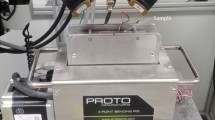We propose an original physically justified method for the evaluation of the spread of values of the critical temperature of brittleness. Its principal distinction from the standard method and advantage over this method is that the spread of data is determined according to the source data used for the evaluation of the critical temperature of brittleness but not according to the set of values of this temperature. We introduce quantitative characteristics of a series of impact-toughness tests aimed at finding the critical temperature of brittleness: the effective number of experimental points and the weight (degree of influence) of each of these points on the critical temperature of brittleness. A criterion of sufficiency of the number of values of impact toughness for the adequate determination of the critical temperature of brittleness according to these values is also proposed. We describe numerous experiments that reveal good correlation between the spread of values of the critical temperature of brittleness obtained by the proposed method and the corresponding standard deviations.








Similar content being viewed by others
References
GOST 25.506-85. Strength Analysis and Tests in Mechanical Engineering. Methods for Mechanical Testing of Metals. Determination of the Characteristics of Crack Resistance (Fracture Toughness) under Static Loading [in Russian], Izd. Standartov, Moscow (1985).
ASTM E399-12е3. Standard Test Method for Linear-Elastic Plane-Strain Fracture Toughness K IC of Metallic Materials, ASTM, Philadelphia (2012).
PNAÉ G-7-002-86. Norms of Strength Analyses for the Equipment and Pipelines of Nuclear Power Plants [in Russian], Énergoatomizdat, Moscow (1989).
MT-D.0.03.391-09. Methods for the Evaluation the Strength and Service Life of the WWÉR Reactor Vessels in the Process of Operation [in Russian], Mintopénergo Ukrainy, Kiev (2009).
IAEA-TECDOC-1627. Pressurized Thermal Shock in Nuclear Power Plants: Good Practices for Assessment Deterministic Evaluation for the Integrity of Reactor Pressure Vessel, IAEA, Vienna (2010).
ASME Boiler and Pressure Vessel Code, Section XI: Rules for In-Service Inspection of Nuclear Power Plant Components, ASME, New York (2004).
10 CFR 50.61. Title 10 Code of Federal Regulations, Part 50.61, Fracture Toughness Requirement for Protection Against Pressurized Thermal Shock Events. NRC, Washington (2013).
PM-T.0.03.120-08. Typical Program for Monitoring the Properties of the Metal in WWÉR-100 Reactor Vessels by Using Reference Specimens [in Russian], “Énergoatom” National Nuclear Power Generating Company State Enterprise, Kiev (2008).
Unified Procedure for the Lifetime Assessment of Components and Piping in WWÉR NPPs, “VERLIFE” Version 2008, European Commission (2008).
Regulatory Guide 1.99, Revision 2, Radiation Embrittlement of Reactor Vessel Materials, Office of Nuclear Regulatory Research, NRC, Washington (1998).
KTA 3203 (6/01). Safety Standards of the Nuclear Safety Standards Commission (KTA). Surveillance of the Irradiation Behavior of Reactor Pressure Vessel Materials of LWR Facilities, KTA, Salzgitter (2001).
JSME Codes for Nuclear Power Generation Facilities, S NC1-2001, “Rules on Design and Construction for Nuclear Power Plant,” JSME, Tokyo (2001).
R. K. Nanstad, D. E. McCabe, and R. L. Swain, “Evaluation of variability in material properties and chemical composition for midland reactor weld WF-70,” in: Effects of Radiation on Materials. ASTM STP 1325, ASTM, Philadelphia (1999), pp. 125–156.
RD ÉО 0598-2004. A Procedure for the Determination of the Temperature of Critical Brittleness for the Materials of Reactor Vessels According to the Results of Testing of Undersized Specimens for Impact Bending [in Russian], Rosénergoatom, Moscow (2004).
Report of the Completion of Works: “Reconstitution and Testing of Reconstituted Reference Charpy- and COD-Type Specimens of WWÉR-1000 Reactor Vessels for Static Fracture Toughness and Impact Bending. Stage 3. Tests of Irradiated Reconstituted Reference Charpy- and COD-Type Specimens from a Power-Generating Unit of the South-Ukrainian Nuclear Power Plant-1 (3L Set)” [in Russian], Institute for Nuclear Research, Ukrainian National Academy of Sciences, Kiev (2010).
IAEA-TECDOC-1441. Effects of Nickel on Irradiation Embrittlement of Light Water Reactor Pressure Vessel Steels, IAEA Vienna (2005).
I. Orynyak, M. Zarazovskii, and A. Bogdan, “Determination of the transition temperature scatter using the Charpy data scatter,” in: Proc. of ASME 2013 Pressure Vessels and Piping Conf., Paper No. PVP2013-97697.
1152.75.00.000 TO. Reference Specimens. Technical Description and Operating Manual [in Russian], Moscow (1979).
Report of the Completion of Works “Complex Laboratory Investigations for the Determination of the Actual Physicomechanical Properties of the Metal of a Unit in the Zone of Weld 111” [in Russian], Énergoatom National Nuclear Power Generating Company Scientific and Technical Center, Kiev (2013).
Author information
Authors and Affiliations
Corresponding author
Additional information
Translated from Fizyko-Khimichna Mekhanika Materialiv, Vol. 51, No. 1, pp. 26–36, January–February, 2015.
Rights and permissions
About this article
Cite this article
Orynyak, I.V., Zarazovskii, М.N. & Bogdan, A.V. A Method for the Evaluation of the Critical Temperature of Brittleness with Regard for the Spread of the Experimental Data on Impact Toughness. Mater Sci 51, 23–36 (2015). https://doi.org/10.1007/s11003-015-9806-z
Received:
Published:
Issue Date:
DOI: https://doi.org/10.1007/s11003-015-9806-z




